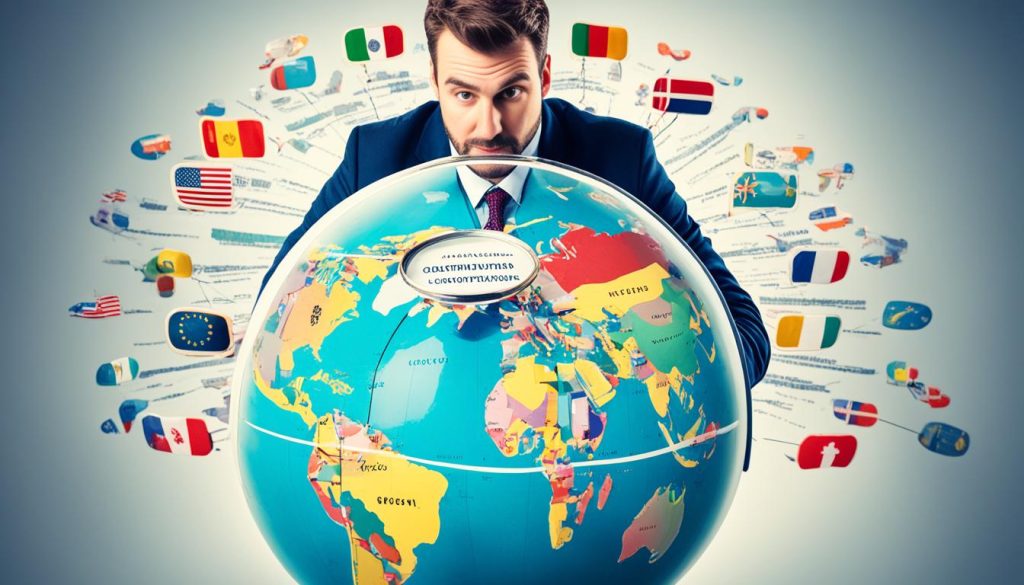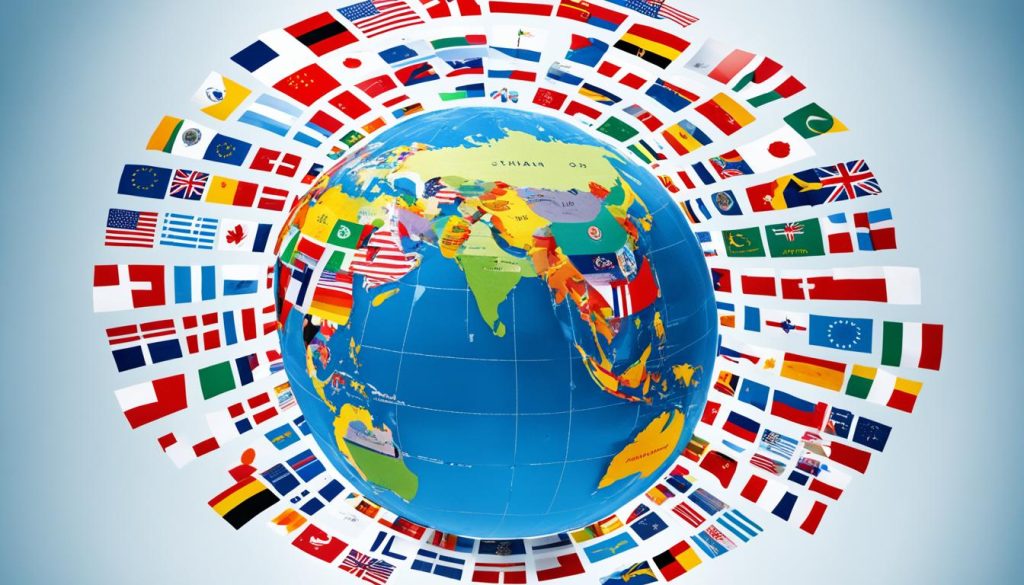The path to becoming a multinational company is complex and well-planned. Firms pursue global expansion to enter foreign markets. This is for more opportunities and growth.
This journey involves stages like detailed market research and developing corporate growth strategies. They must also understand legal and fiscal rules. It’s essential to have good cross-cultural communication and to streamline operations internationally.
Knowing what defines a multinational company is key. Such companies have a big footprint in many countries. They use international trade to get resources, enhance production, and increase sales worldwide. Harvard Business Review and the Federation of International Trade Associations offer deep insights into global business.
Key Takeaways
- Embarking on a multinational journey includes thorough market research and strategic planning.
- Effective navigation of legal and fiscal frameworks is essential for global success.
- Cross-cultural communication and operations are key to multinational operations.
- A multinational company leverages resources, production, and sales across various countries.
- References such as Harvard Business Review and Federal of International Trade Associations offer valuable insights.
Understanding Multinational Corporations
Multinational entities play a big role in the world economy, with operations in many countries. They deal with different cultures and laws. Their goals include expanding markets and improving costs while handling complicated management and political risks.
The United Nations Conference on Trade and Development speaks highly of them. According to the World Trade Organization, they make up a large part of the global economy. They lead in innovation and make work more productive across countries.
Running a business in different countries comes with its own set of issues and advantages. For example, they must fit into various regulatory environments, work cultures, and shopping trends. This flexibility helps them use local strengths and keep a united global business plan.
The Financial Times offers case studies on big multinational companies. These examples show how to mix global standards with local needs. Learning from these businesses can help new companies grow internationally.
Benefits of multinational corporations include:
- Entering new markets
- Saving costs
- Boosting new ideas
Yet, they face some obstacles:
- Dealing with political risks
- Handling complex management
- Adjusting to different cultures
In the end, multinational corporations have a big and complex role in the world market. They shape economic scenes and lead in international business methods.
The Role of Market Research
Market research is key to crafting a win in market strategy. It sheds light on the size of the market, what customers want, and who else is competing. This knowledge lets companies make smart moves when entering new markets.
Identifying Potential Markets
Finding the right markets involves looking at economic, social, and political aspects. The Global Market Insights report mentions using various research tools. These help figure out if a market is a good fit for entry.
Analysing Market Demand
Knowing what people want to buy is essential. McKinsey & Company talks about using forecasts and trends to see into the future. This type of research is crucial for planning products and marketing strategies.
Competitor Analysis
Checking out the competition is very important. It lets companies see where they stand. The story of how Samsung succeeded in India shows how understanding competitors helps. It leads to making smart moves and growing in new markets.
Investment Strategies for Global Expansion

When expanding globally, good planning and the right investment strategies are key. Companies looking at international growth have different ways to go about it. Options like joint ventures, mergansions, and greenfield investments meet various needs and risk levels. It’s very important to pick the right one for success in the long run.
One popular strategy is foreign direct investment (FDI). This means starting or buying businesses in another country. FDI lets a company control everything but comes with high costs and risks. The World Bank says FDI helps build economic connections and understand the market better.
Forming strategic alliances is another good approach. These partnerships help get into new markets and lower risks by sharing resources and know-how. Bloomberg has shared stories of how effective strategic alliances are for entering new markets. Companies use the strengths of local partners to overcome challenges.
- Joint Ventures: Two or more companies work together for mutual benefits in a new market.
- Mergers & Acquisitions: This means joining with or buying a local company to quickly capture market share.
- Greenfield Investments: Starting new operations from scratch, preferred for full control but needs a lot of investment.
Choosing an investment strategy must match a company’s goals and how much risk it can take. For example, those who don’t like risk might pick joint ventures or alliances. They share the risks. But, more daring businesses might go for acquisitions or greenfield investments for more control.
Cross-border investments need careful thought. They involve financial and strategic plans. The Journal of International Business Studies notes that cross-border mergansions can lead to competitive edges. They bring synergies and different income sources.
| Investment Option | Key Characteristics | Example |
|---|---|---|
| Joint Ventures | Shared risk and resources | Ford and Mahindra |
| Mergers & Acquisitions | Rapid market entry | Amazon’s acquisition of Whole Foods |
| Greenfield Investments | Full control, high investment | Tesla Gigafactory in Shanghai |
| Strategic Alliances | Resource sharing, local expertise | Starbucks and Tata Global Beverages |
In conclusion, picking the right investment strategy for global growth is crucial. It needs thinking about the company’s aims, risk willingness, and market situations. By using cross-border investments, strategic alliances, and FDI wisely, companies can tackle the challenges of international markets. They can grow sustainably, too.
Establishing an International Business Model
When a company expands globally, it’s key to develop a strong international business model. This requires strategic choices in organisational structure and an understanding of cross-cultural management.
Choosing the Right Business Structure
Finding the right organisational structure is crucial for global success. Choices like subsidiaries, franchises, and branch offices each have their pros and cons. For instance, subsidiaries offer control but are expensive to set up.
Harvard Business School points out that effective structures improve management and align every unit with the business’s core operations.
Cultural Adaptation in Business Practices
Adapting to different cultures is vital for managing across borders. Understanding local cultures enhances customer relations and boosts business. Using local product versions, marketing tweaks, and custom business practices can give an edge.
The Global Management Journal suggests that cultural sensitivity aids in long-term success. Moreover, the International Business Review shows how cultural adaptation is key for multinational success.
It’s also about adjusting management to fit a diverse workforce. This promotes teamwork and collaboration internationally.
By melding the right structure with a model that respects cultural differences, firms build a solid base for worldwide efforts.
Legal Considerations for Multinational Companies
Operating in different countries brings complex legal issues. Companies have to understand international laws and protect their rights. They need to follow laws in each place they work.
It’s important to follow local laws, work rules, and taxes. Different places have their own laws, so companies must learn a lot. The International Chamber of Commerce says planning well helps avoid risks. And, keeping ideas safe is a must, as the World Intellectual Property Organization points out.
To keep on top of legal matters, getting advice from experts is key. Here’s a comparison:
| Aspect | Local Compliance | International Strategy |
|---|---|---|
| Legal Framework | Employment Laws, Tax Codes | International Corporate Law |
| Risk Management | Local Legal Teams | Coordination with Global Legal Advisors |
| Intellectual Property | National IP Registrations | Global Protection Strategies |
Understanding legal needs deeply is key to being successful worldwide. The Journal of International Business Law shows through case studies how top firms manage legal challenges. They make sure they follow the law and protect their rights.
Navigating International Regulations

For multinational companies, understanding and following international laws and standards is key. They need to get through trade barriers and manage compliance well. This helps them do well in different countries.
Trade Regulations
Global trade barriers, like tariffs and quotas, really shape competition. The World Trade Organization (WTO) sets guidelines on trade that companies must follow. Learning these rules is crucial for a strong regulatory strategy.
Different areas might put in place special tariffs or ask for certain certifications. This affects how a company enters a market and what it costs to operate there.
| Region | Key Trade Barriers | Impact on Business |
|---|---|---|
| European Union | Customs duties, Product standards | Access restricted to compliant products |
| North America | Tariffs, Trade quotas | Increased costs for non-NAFTA products |
| Asia-Pacific | Local sourcing requirements | Mandates investment in local industries |
Compliance Requirements
Operating in different places means dealing with many regulations. For example, in Europe, GDPR sets strict data privacy rules. Also, environmental rules require companies to operate in green ways.
Having one regulatory strategy can make compliance easier. Using a central compliance system helps follow various rules, avoiding legal trouble and keeping operations smooth.
For more information, the Journal of Compliance, Ethics, and Risk Management offers analyses and case studies. These resources help companies improve their strategies and keep up with rules with less trouble.
How Does a Company Become Multinational?
Turning a local business into a global one needs careful planning, resource management, and finding the right people. It’s important to start with a strong base to become a successful multinational company.
Initial Steps for Transitioning to Multinational Status
The first steps to going global include detailed strategy work. The Boston Consulting Group says businesses should plan their goals, manage resources well, and get talented people from around the world. Getting these basics right helps a company grow internationally.
Scaling Operations Globally
Growing a business worldwide means managing supply chains and logistics better and making sure processes are the same everywhere. Stories from the International Business Times and industry expert talks at the World Economic Forum show how tricky this can be. But, with the right strategy, these challenges can be overcome, leading to growth on a global scale.
Financial Planning for Multinational Growth
Effective financial planning is key for multinational corporations to grow. It involves careful budgeting, forecasting, and risk checking. This ensures stability and the chance to grow in global markets. A solid plan helps handle the risks from currency changes and cross-border financing.
When going global, it’s important to look at different financing ways. Financial managers need to look at equity financing, debt options, and hybrids. They must pick the best way for entering new markets. The International Monetary Fund says it’s crucial to match financing with long-term goals to avoid pitfalls.
Global financial planning is complex. Managers must deal with currency rates, profit sending back home, and international taxes. Currency changes can greatly impact cash flow and profit. The Harvard Business Review shows how currency swaps and forward contracts can help against these risks.
Handling money for a global business means knowing a lot about international tax laws. Good tax planning and following laws in every place can save multinational companies from big fines. It also helps their finances. The Financial Times gives useful insight into how top companies deal with their global finances and stay up to date with laws.
Strategic planning and knowing the global market well are crucial. They help multinational companies not just survive but do well in the competitive global scene.
The Importance of International Marketing Strategies
Creating strong international marketing strategies is key for companies wanting to go global. A smart plan helps a brand connect with people across various markets.
Localising Marketing Campaigns
The heart of a great global brand strategy is market localisation. It’s about shaping marketing efforts to fit local tastes, values, and languages without losing the brand’s core identity. For example, McDonald’s changes its menu to appeal to local diners while keeping its signature look.
Following the American Marketing Association’s advice, knowing the local culture is vital for making messages that truly speak to customers.
- Translation and cultural adaptation of marketing materials
- Collaboration with local influencers and media
- Responsive customer service in local languages
- Adapting products to meet local tastes and preferences
Success stories from the International Advertising Bureau show brands like Coca-Cola changing their messages and products for different global markets.
Digital Marketing in Global Landscapes
The importance of digital marketing grows every day. As businesses expand globally, using digital platforms is crucial. Social media, SEO, and online ads are key to reaching people around the world.
Studies in the Journal of Marketing Communications reveal digital marketing’s power. It’s good at targeting specific groups and measuring how well campaigns do. Brands like Nike use digital tools to keep a unified global identity while talking to local audiences in their own way.
Here are some top strategies for effective international advertising:
| Strategy | Description | Examples |
|---|---|---|
| Social Media Campaigns | Connecting with folks using platforms like Facebook, Instagram, and Twitter | Nike’s “Just Do It” with regional influencers |
| Search Engine Optimisation | Making sure content shows up in searches all over the world | Google’s content localisation efforts |
| Programmatic Advertising | Buying ads automatically to reach certain groups | Amazon’s personalised ads |
Using these methods, firms can dive into international markets successfully. They ensure that their brand stays interesting and relevant everywhere.
Building a Multinational Workforce
In today’s world economy, having a diverse, multinational workforce is key for big companies. Cross-border recruitment is a main method to achieve this. It helps businesses find talents worldwide, encouraging diversity and inclusiveness right from the start.
Managing international staff well is crucial for keeping and nurturing this talent. The Society for Human Resources Management notes the importance of employee growth. Training programs and mentorship lead to better retention and team performance. A company culture that values different cultures also boosts teamwork and outputs.
Managing global talent includes following labour laws in various countries. Knowing these laws is vital for both obeying rules and keeping good employee relations. Deloitte says companies that focus on compliance training handle these issues better.
| Key Aspects | Best Practices |
|---|---|
| Recruitment | Utilise cross-border recruitment to access global talent pools |
| Training and Development | Implement robust development programmes to enhance skills |
| Corporate Culture | Cultivate an inclusive environment to foster team cohesion |
| Compliance | Invest in training and consultation to navigate international labour laws |
Harvard Business Review case studies show how well multinational workforce integration can work. These examples reveal companies focusing on global talent management and diversity achieve great employee satisfaction. They also become more innovative and competitive worldwide.
In summary, through effective global HR strategies, businesses can create a strong, diverse, and innovative workforce. Cross-border recruitment, employee development, and legal compliance are essential. These efforts lead to a successful multinational workforce.
Technology and Innovation in Global Operations
Effective global IT is key to better business performance and a strong competitive advantage. Using global technology wisely can make operations smooth, keep things the same in different places, and encourage always getting better.
Implementing Global Technology Solutions
Multinational companies must embrace global technology to stay connected across all markets. International IT makes sure systems and ways of working match everywhere. Gartner says using common platforms and the same software saves money and boosts how well things work.
Innovative Practices Across Borders
Sharing new ideas and the best ways of doing things between countries is key for big companies. They get unique insights and improve by learning from each place. MIT’s Technology Review talks about teamwork and partnerships that overcome long distances.
| Strategy | Benefit | Example |
|---|---|---|
| Unified Platforms | Cost Savings | Global CRM Systems |
| Collaborative Projects | Enhanced Innovation | R&D Joint Ventures |
| Standardised Software | Improved Performance | ERP Solutions |
However, sharing technology has its issues. Intellectual property laws and local rules are big obstacles. Reports from the industry talk about these ups and downs. They show the need for good control and careful planning.
Managing Global Supply Chains

Running global supply chains well is vital for big companies’ long-term win. They grow worldwide and sort out complexities, like how goods move and are stored, in many places. Using supply chain optimisation tricks is key to stay efficient and ahead in the game.
It’s critical to manage supplier relationships and pick where to buy stuff carefully. This keeps product quality high and consistent. The International Journal of Operations & Production Management shares deep thoughts on these topics. It shows how they help smooth global supply flows.
Also, new tech, especially in understanding data, boosts managing global supply chains. Tools that analyse data help firms see their work clearer. This leads to smarter choices that boost efficiency. The Council of Supply Chain Management Professionals shared a case study. It shows the real pluses of using such techs in supply chain optimisation.
| Aspect | Impact on Supply Chain |
|---|---|
| International Sourcing | Ensures quality and cost-effectiveness |
| Global Logistics | Improves distribution and delivery times |
| Data Analytics | Enhances decision-making and operational efficiency |
The Journal of Business Logistics adds to why global logistics is so important. It shows that managing how goods are moved and delivered can cut costs. It can also make customers happier.
By following the best methods in supply chain management, big international companies can handle global challenges better. They make sure their supply chains are strong, quick to react, and support steady growth.
Adapting to Cultural Differences
Today, it’s key for multinational companies to understand and adapt to cultural differences. Embracing cross-cultural skills leads to stronger global teams and better performance in diverse environments.
Cross-Cultural Training Programs
Cross-cultural training prepares staff for working internationally. It helps them appreciate and navigate different cultures. Key training features include:
- Understanding cultural values and practices
- Developing cultural sensitivity
- Learning about cultural communication styles
The Academy of Management Journal tells us that good training greatly improves employee adaptability and global performance.
International Communication Skills
Intercultural communication is vital for any smooth-running global business. Skills like active listening and cultural empathy are crucial. They help staff do well in international negotiations and teamwork.
Investing in intercultural training sets companies up for success abroad, says the Journal of International Business Studies. This training enhances teamwork and success in global ventures.
| Skill | Impact on Global Operations |
|---|---|
| Cultural Sensitivity | Enhanced mutual respect among team members |
| Active Listening | Improved understanding and fewer miscommunications |
| Negotiation Tactics | Better resolution of conflicts and collaborative agreements |
The International Journal of Intercultural Relations backs up the benefits of intercultural training. It encourages businesses to make it a regular part of training.
Securing International Partnerships
Forming successful cross-border partnerships is key. It needs a strategic focus on alignment, cultural fit, and shared goals. For multinational companies, these partnerships open doors to new markets and resources. They also boost competitive standing.
Companies must check the partner’s reputation, how they operate, and financial health. These are crucial for a partnership to work.
Take Starbucks and Tata Global Beverages as examples. Their alliance improved their market reach by using each other’s strengths. Renault and Nissan also show how cross-border partnerships lead to growth and new ideas.
Key Benefits of Cross-Border Partnerships:
- Market Entry: They ease entry into new markets, avoiding tough regulations.
- Resource Sharing: Partners share tech and know-how, cutting costs and fueling innovation.
- Competitive Positioning: They sharpen a company’s edge through strong international ties.
The Chamber of Commerce says international partnerships boost business ability, promoting growth and lasting success. The Journal of International Business Studies supports this, showing the importance of joint ventures and alliances for long-term achievement.
The Harvard Business Review highlights the value of long-term global networks. Investing in these relationships brings market insights and better efficiency.
As shown below, multinational corporations gain a lot from strategic international partnerships:
| Benefit | Example |
|---|---|
| Market Entry | Starbucks & Tata Global Beverages |
| Resource Sharing | Renault & Nissan |
| Competitive Positioning | Unilever & Nestlé |
Case Studies of Successful Multinational Companies
Looking into how big companies succeed teaches us a lot. Companies like Apple, Toyota, and Nestlé show us how it’s done in the global scene. They’ve managed to grow big by excelling in international best practices.
These businesses faced many hurdles from starting in new markets to growing big. Apple’s success is built on detailed market research and a strong marketing plan worldwide. Toyota has grown by adapting its making of things and making sure its products suit local tastes.
The Journal of International Business Studies shares how these companies tackle challenges abroad. The Harvard Business Review gives detailed stories on using new ideas to stay ahead globally. These studies highlight how crucial it is to use special strategies and innovation for long-term success.
















